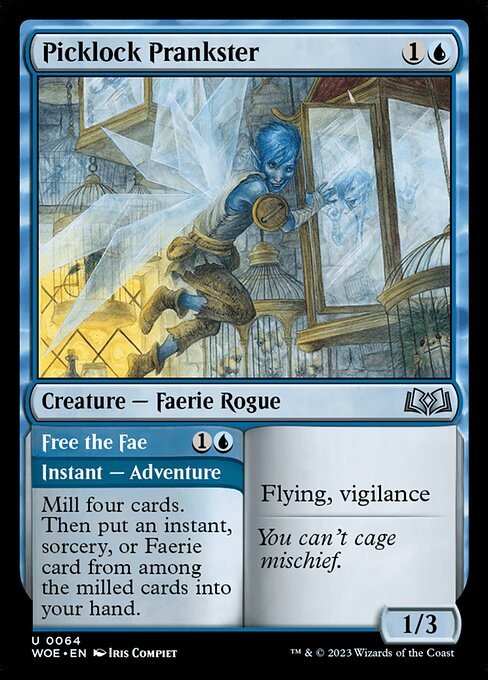
Top Performing Decklists
| Deck | Creator | Record | Best Finish |
|---|---|---|---|
| Unknown Archetype | ugandasrankone | 5-0 | 1st in MTGO Standard League #8949 |
Performance Stats (Last 14 Days)
Win Rate Impact
Top Table Win Rate
Meta Trend
Sample Size
Tournament Results
Average Copies
Archetypes Using This Card:
Azorius Omniscience , Azorius Tempo , Bant Tempo , Dimir Faeries , Dimir Midrange , Dimir Reanimator , Dimir Tempo , Esper Oculus , Esper Raise , Jeskai Equipments
Meta Performance Analysis
Picklock Prankster ranks #72 out of approximately 310 cards in raw efficiency (top 23%).
Game Impact Factor
Color Differential
Blue average: 52.8%
Performance compared to other Blue cardsBased on our comprehensive multi-metric analysis, Picklock Prankster is a solid card that performs above average in the current meta.
Recommended number of copies: 2
Win Rate Timeline
Card Efficiency Analysis
Raw Efficiency (Win Rate/Mana)
Relative Efficiency
Performance Efficiency: 50.00 (Win rate × Top 8 rate ÷ Mana value)
At 2 mana, the average win rate in the format is 71.6%. Picklock Prankster has a win rate of 100.0%, making it 39.6% better than other 2-mana cards.
Top Performing Partners
| Card Name | Type | Deck Count | Win Rate | 1st Places |
|---|---|---|---|---|
| Stormchaser's Talent | Enchantment — Class | 14 | 80.4% | 7 |
| Up the Beanstalk | Enchantment | 16 | 79.7% | 7 |
| Bushwhack | Sorcery | 15 | 78.3% | 7 |
| Eddymurk Crab | Creature — Elemental Crab | 15 | 78.3% | 7 |
| Seed of Hope | Instant | 15 | 78.3% | 7 |
| Tolarian Terror | Creature — Serpent | 15 | 78.3% | 7 |
| Analyze the Pollen | Sorcery | 16 | 75.9% | 7 |
| Pick Your Poison | Sorcery | 15 | 72.8% | 7 |
| Cache Grab | Instant | 17 | 71.5% | 7 |
| Pawpatch Formation | Instant | 17 | 70.9% | 7 |
Card Synergy Analysis
Cards that perform better with Picklock Prankster than they do on average. A positive synergy score indicates stronger performance together.
| Card Name | Type | Mana | Decks | Win Rate Together | Win Rate Apart | Synergy Score |
|---|
Top Archetypes
| Archetype | Deck Count | % of Archetype | Win Rate |
|---|---|---|---|
| Azorius Tempo | 395 | 99.8% | 41.8% |
| Azorius Omniscience | 174 | 54.7% | 46.6% |
| Sultai Emergence | 35 | 97.2% | 16.3% |
| Dimir Midrange | 21 | 1.0% | 31.3% |
| Simic Terror | 15 | 4.9% | 78.3% |
Statistics Explanation
| Statistic | Description | Formula |
|---|---|---|
| Win Rate Impact | How much this card increases or decreases the win rate of decks that include it, compared to the average deck in the format. | (Win rate of decks with this card) - (Average win rate of all decks) |
| Top Table Win Rate | A weighted win rate that gives more significance to performance in higher tournament placements. First place finishes count for 2x, with diminishing weight down to 8th place. | ∑(wins × placement_weight) / ∑((wins + losses) × placement_weight) |
| Meta Trend | Shows if the card is performing better or worse in the most recent period compared to earlier periods. Positive values indicate improving performance. | (Win rate in recent half of time period) - (Win rate in earlier half of time period) |
| Confidence Factor | A measure of statistical reliability based on sample size. The progress bar indicates how confident we are in the statistics (with larger sample sizes providing higher confidence). | log10(Number of decks + 1) |
| Average Copies | The average number of copies of this card included in decks that use it. | ∑(Copies in each deck) / (Number of decks) |
| Card Synergy Score | Measures how well this card performs with other cards compared to their individual performance. | (Win rate together) - (Average of individual win rates) |
| Raw Efficiency | Win rate points per mana invested. Higher values indicate better returns on mana investment. | (Win rate) / (Mana value) |
| Relative Efficiency | How efficient this card is compared to the average card of the same mana value. | ((Win rate) / (Format average win rate for same mana)) / (Mana value) |
| Performance Efficiency | Combined metric that accounts for win rate, tournament success, and mana investment. | (Win rate × Top 8 placement rate) / (Mana value) |
| Game Impact Factor | A measure of how much this card affects game outcomes, based on win rate adjusted by its deviation from the format average. | Win rate × (1 + (Win rate - Format average) / 100) |
| Color Differential | How this card's win rate compares to the average win rate of other cards of the same color. | Win rate - Average win rate for same color |
All statistics are calculated using tournament data from the selected time period. Sample sizes below 10 decks may not provide statistically significant results.